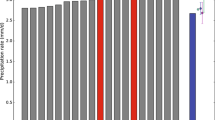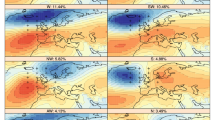Abstract
A new atmospheric model has been developed jointly by Météo-France, and the European Centre for Medium-range Weather Forecasts (ECMWF) under the acronyms ARPEGE (action de recherche petite echelle grande echelle, which means research project on small and large scales) and IFS (integrated forecast system). This model includes, inter alia, an atmospheric general circulation model (GCM) which is intended by the French climate modelling community to be used for studying the anthropogenic climate impact. A preliminary version of this model has been available since 1992. This paper describes its main characteristics. Three 10-year integrations of this model having spectral horizontal resolutions of T21, T42, and T79 have been performed using prescribed monthly mean sea surface temperatures (SST) observed from 1979 until 1988. The results of these integrations are presented and compared with the observed climatology. The comparison is made for the winter (DJF) and summer (JJA) periods. It is shown that the model is capable of reproducing the observed climatology in a generally successful manner.
Similar content being viewed by others
References
Asselin RA (1972) Frequency filter for time integration. Mon Weather Rev 100:487–490
Barkstrom BR, Smith GL (1986) The Earth Radiation Budget Experiment: science and implementation. J Geophys Res 24:379–390
Baumgartner A, Mayer H, Mertz W (1977) Weltweite Vergeilung des Rauhigkeits-Parameters ζo mit Anwendung auf die Energiedissipation an der Erdoberfldche. Meteorol Rundsch 30:43–48
Boer G, Arpe K, Blackburn M, Déqué M, Gates WL, Hart TL, Le Trent H, Roeckner E, Sheinin DA, Simmonds I, Smith RNB, Tokioka T, Wetherald RT, Williamson D (1992) Some results from an intercomparison of the climates simulated by 14 atmospheric general circulation models. J Geophys Res 97:12771–12786
Bougeault P (1985) A simple parameterization of the large-scale effects of deep cumulus convection. Mon Weather Rev 113:2108–2121
Boville BA, Cheng X (1988) Upper boundary effects in a general circulation model. J Atmos Sci 45:2592–2606
Boville BA (1991) Sensitivity of simulated climate to model resolution. J Clim 4:469–485
Cariolle D (1991) The French Community Climate Model: specifications. Available upon request to the author at CNRM 42 Av Coriolis 31057 Toulouse France
Cariolle D, Déqué M (1986) Southern hemisphere medium-scale waves and total ozone disturbances in a spectral general circulation model. J Geophys Res 91:10825–10846
Cariolle D, Lasserre-Bigorry A, Royer JF, Geleyn JF (1990) A GCM simulation of the springtime antarctic ozone decrease and its impact on midlatitudes. J Geophys Res 95:1883–1898
Cariolle D, Amodei M, Simon P (1992) Dynamics and the ozone distribution in the winter stratosphere: modelling the interhemispheric differences. J Atmos Terr Phys 54:627–640
Cess RD, Potter GL, Blanchet JP, Boer GJ, Del Genio AD, Déqué M, Dymnikov V, Galin V, Gates WL, Gahn SJ, Kiehl JT, Lacis AA, Le Trent H, Li ZX, Liang XZ, McAvaney BJ, Meleshko VP, Mitchell JFB, Morcrette JJ, Randall DA, Rikus L, Roeckner E, Royer JF, Schlese U, Sheinin DA, Slingo A, Sokolov AP, Taylor KE, Washington WM, Wetherald RT, Yagai I, Zhang M-H (1990) Intercomparison and interpretation of climate feedback processes in 19 atmospheric general circulation models. J Geophys Res 95:16001–16615
Clark TL, Peltier WR (1984) Critical level reflection and the resonant growth of nonlinear mountain waves. J Atmos Sci 41:3122–3134
CLIMAP (1981) Seasonal reconstruction of the earth surface at the last glacial maximum. Geological Society of America Map Chart Series MC-36
Clough SA, Franks RAA (1991) The evaporation of frontal and other stratiform precipitation. Q J R Meteorol Soc 117:1057–1080
Courtier P, Geleyn JF (1988) A global numerical weather prediction model with variable resolution: application to the shallow water equations. Q J R Meteorol Soc 114:1321–1346
Courtier P, Freydier C, Geleyn JF, Rabier F, Rochas M (1991) The ARPEGE project at METEO-FRANCE. In: Proc ECMWF Workshop. Numerical methods in atmospheric modelling, 9–13 Sept 1991, vol 2, p 193–231. ECMWF, Shinfield Park, Reading, UK
Crutcher HL, Meserve JM (1970) Selected level heights, temperatures and dewpoints for the Northern Hemisphere. US Naval Weather Service, Navair 50-IC-52
Deardorff JW (1977) A parameterization of ground surface moisture content for use in atmospheric prediction models. J Appl Meteorol 16:1182–1185
Dreveton C, Déqué M, Geleyn JF (1993) Interactions of physical parameterizations in the climate version of the ARPEGE/IFS model. Beitr Phys Atmos 66:283–303
Déqué M, Dreveton C, Braun A, Cariolle D (1993) ARPEGE/IFS: the climate version 0. METED-FRANCE/CNRM Techn Note 23
Eliasen E, Machenhauer B, Rasmussen E (1970) On a numerical method for integration of the hydrodynamical equations with a spectral representation of the horizontal fields. Report of the Institut for Teoretisk Meteorologi 2 (Cobenhaven University): 35 pp
Fels SB (1986) Analytic representations of standard atmosphere temperature profiles. J Atmos Sci 43:219–221
Gates WL (1992) AMIP: the atmospheric model intercomparison project. Bull Am Meteorol Soc 73:1962–1970
Geleyn JF (1987) Use of a modified Richardson number for parameterizing the effect of shallow convection. J Meteorol Soc Japan Spec NWP Symp Vol: 141–149
Geleyn JF (1988) Interpolation of wind, temperature and humidity values from model levels to the height of measurement. Tellus 40A:347–351
Geleyn JF, Hollingsworth A (1979) An economical analytic method for the computation of the interaction between scattering and line absorption of radiation. Beitr Phys Atmos 52:1–16
Geleyn JF, Preuss HJ (1983) A new dataset of satellite derived surface albedo values for operational use at ECMWF. Arch Meteorol Geophys Bioklimatol, Ser A 32:353–359
Herman JR, Hudson R, McPeters R, Stolarski R, Ahmad Z, Gu XG, Taylor S, Wellemeyer C (1991) A self-calibration method applied to TOMS/SBUV backscattered ultraviolet data to determine long-term global ozone change. J Geophys Res 96:7531–7545
Jenne RL, Crutcher HL, van Loon H, Taljaard JJ (1974) A selected climatology of the southern hemisphere: computer method and data availability. NCAR TN/STR 92
Kalnay E, Kanamitsu M, Pfaendtner J, Sela J, Suarez M, Stackpole J, Tuciilo J, Umscheid L, Williamson D (1989) Rules for interchange of physical parameterizations. Bull Am Meteorol Soc 70:620–622
Legates DR, Willmott CJ (1990) Mean seasonal and spatial variability in gauge-corrected global precipitation. Int J Climatol 10:111–127
Louis JF (1979) A parametric model of vertical eddy fluxes in the atmosphere. Bound Layer Meteorol 17:187–202
Louis JF, Tiedtke M, Geleyn JF (1982) A short history of the operational PBL-parameterization at ECMWF. In: Pro ECMWF Workshop Planetary boundary layer parameterization, 25–27 November 1981, pp 59–80 ECMWF, Shinfield Park, Reading, UK
Mahfouf JF, Cariolle D, Royer JF (1993) Simulation de l'effet d'un doublement du gaz carbonique sur l'ozone stratospherique. CR Acad Sci 316 Serie 11:61–68
McFarlane NA, Boer GJ, Blanchet JP, Lazare M (1992) The Canadian Climate Centre second-generation general circulation model and its equilibrium climate. J Clim 5:1013–1044
Miller J, Beljaars ACM, Palmer TN (1992) The sensitivity of the ECMWF model to the parameterization of evaporation from the tropical oceans. J Clim 5:418–434
Noihlan J, Planton S (1989) A simple parameterization of land surface processes for meteorological models. Mon Weather Rev 117:536–549
Orszag SA (1970) Transform method for calculation of vector coupled sums: application to the spectral form of the vorticity equation. J Atmos Sci 27:890–895
Palmer TN, Brankovic C, Molteni F, Tibaldi S (1990) Extended range predictions with ECMWF models: I interannual variability in operational model integrations. Q J R Meteorol Soc 116:799–834
Randel WJ, Williamson DL (1990) A comparison of climate simulated by the NCAR community climate model (CCM1: R15) with ECMWF analyses. J Clim 3:608–633
Reynolds RW (1988) A real-time global sea surface temperature analysis. J Clim 1:75–86
Ritter B, Geleyn JF (1992) A comprehensive radiation scheme for numerical weather prediction models with potential applications in climate simulations. Mon Weather Rev 120:303–325
Rossow WB, Mosher F, Kinsela E, Arking A, Desbois M, Harrisson E, Minnis P, Ruprecht E, Seze G, Simmer C, Smith E (1985) ISCCP cloud algorithm intercomparison. J Clim Appl Meteorol 24:877–903
Royer JF (1986) Correction of negative mixing ratios in spectral models by global horizontal borrowing. Mon Weather Rev 114:1406–1410
Simmons AJ, Burridge DM (1981) An energy and angular momentum conserving vertical finite-difference scheme and hybrid vertical coordinate. Mon Weather Rev 109:758–766
Stephenson DB, Royer IF (1994a) GCM simulation of the Southern Oscillation from 1979–88. Clim Dyn (in press)
Stephenson DB, Royer JF (1994b) Low-frequency variability of TOMS and GCM total ozone stationary waves associated with the El Niño/Southern Oscillation for the period 1979–88. J Geophys Res (in press)
Temperton C (1991) On scalar and vector transform methods for global spectral models. Mon Weather Rev 119:1303–1307
Thépaut JN, Vasiljevic D, Courtier P, Pailleux J (1993) Variational assimilation of conventional meteorological observation with a multilevel primitive equation model. Q J R Meteorol Soc 119:153–186
Author information
Authors and Affiliations
Rights and permissions
About this article
Cite this article
Déqué, M., Dreveton, C., Braun, A. et al. The ARPEGE/IFS atmosphere model: a contribution to the French community climate modelling. Climate Dynamics 10, 249–266 (1994). https://doi.org/10.1007/BF00208992
Received:
Accepted:
Issue Date:
DOI: https://doi.org/10.1007/BF00208992




